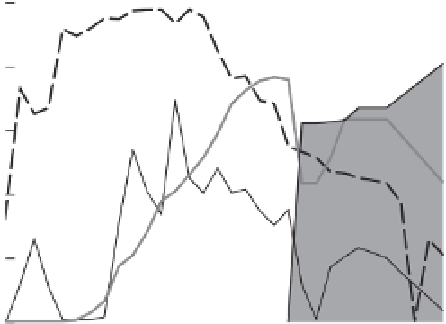Environmental Engineering Reference
In-Depth Information
many parts of Europe. The EEC regulation 2080/92
from 1992 (European Commission (EC) 1992b) aimed
at reducing the area of arable fi elds to reduce subsidies
for surplus of agricultural products, to contribute
towards an improvement in forest resources as well
as of countryside management and environmental
balance, and to absorb CO
2
. In landscapes with high
agricultural intensity, afforestation diminishes the pol-
lution of seepage water with nitrate, which often is a
problem in terms of purifi cation of drinking water.
Natural retention areas can be an important contribu-
tion to fl ood regulation. Up to 1999 about 1 million ha
were afforested in Europe, mostly in Spain and Portugal
(about 650 000 ha; Institut pour le D é veloppement
Forestier (IDF) 2001), and still the calculated afforesta-
tion potential is enormous: in Denmark the political
afforestation aim is 500 000 ha (1995 - 2050), in Ire-
land it is 600 000 ha within 20 years and in Germany
the scenario is 1.2 million ha or more (no time period
indicated; Weber 1998). While there is still a strong
forest decrease worldwide, in Europe the forest area
increases slightly and in China strongly (FAO 2010).
Afforestation of former agricultural land starts with
a soil that contains enormous numbers of microorgan-
isms and insects. Many native plant species may also
be present in the soilborne seed bank or as established
individuals, and the site may often be suitable for tree
growth immediately. Two long-term permanent plot
studies have been established for analysing the vegeta-
tion processes after abandonment of former agricul-
tural areas, including analysis of the infl uence of
different treatments: (1) an abandonment experiment
in Baden-Württemberg (Schreiber 1997), and (2) a
succession experiment in the New Botanical Garden of
G ö ttingen (Figure 12.8 ; Schmidt 1993 ; D ö lle
et al
.
2008). Although the aims of these two studies, as well
as the analysed vegetation types, the geographical situ-
ation and to some degree the methods of recording,
differ in detail, the general trend and message are
obvious: trees will establish and build up forest stands
within a few years to decades, whereas the succes-
sional pathways back to forest may be quite different.
The species composition and the period involved in the
changes depend on the local
species pool
as well as
the vegetation structure at the beginning of the devel-
opmental process.
As a consequence, there are two main options for
afforestation measures on abandoned land:
1.
If there is enough time available and no fi xed
species composition planned for the future forest stand,
100
Herb
80
60
Shrub
40
Moss
Tr e e
20
0
1970
1974
1978
1982
1986
1990
1994
1998
Year
Figure 12.8
Succession experiment in the New Botanical
Garden of Göttingen, Germany. Relative cover (%) of moss,
herb, shrub and tree layers 1968-1999 (free development).
The steep increase of tree cover (shaded area) at the end of
the 1980s occurs when shrubs (< 5 m tall) start gowing
above the 5 m height level. Values for 1994 and 1996-1998
are interpolated. (Based on Schmidt 1993, with new values
for 1993-1999 added; Schmidt, unpublished observations.)
then 'doing nothing but waiting' is an option. Depend-
ing on (a) the presence or absence of mature trees in
the close vicinity and (b) the presence or absence of
small or young individuals of shrubs and trees in the
recent vegetation stand, a patch mosaic will establish
including a large variety of species and structural
types, thus leading to a relatively high degree of natural
biodiversity. The fi nal stage of management-free devel-
opment will be a relatively closed forest canopy anyway.
2.
Usually, however, the highly valued functions of
forests, as mentioned above, require afforestation work
to start as soon as possible, to adapt both species com-
position and future forest structure to the functions
being focused on. Therefore, usually a 'guided develop-
ment ' or ' directing ecological succession ' (Luken 1990 )
of such forest stands is preferred. Native tree species
(see PNV, section 12.1), in temperate Europe especially
deciduous trees (e.g.
Fagus sylvatica
,
Quercus robur and
Q. petraea
), are aimed at and should be preferred in
growing-stock objectives. Some tree species such as ash
(
Fraxinus excelsior
), sycamore maple (
Acer pseudoplata-
nus
), cherry tree (
Prunus avium
) and mountain elm
(
Ulmus glabra
) may benefi t from the generally favour-
able soil conditions of the abandoned fi elds and
meadows, but this high nutrient status associated with







